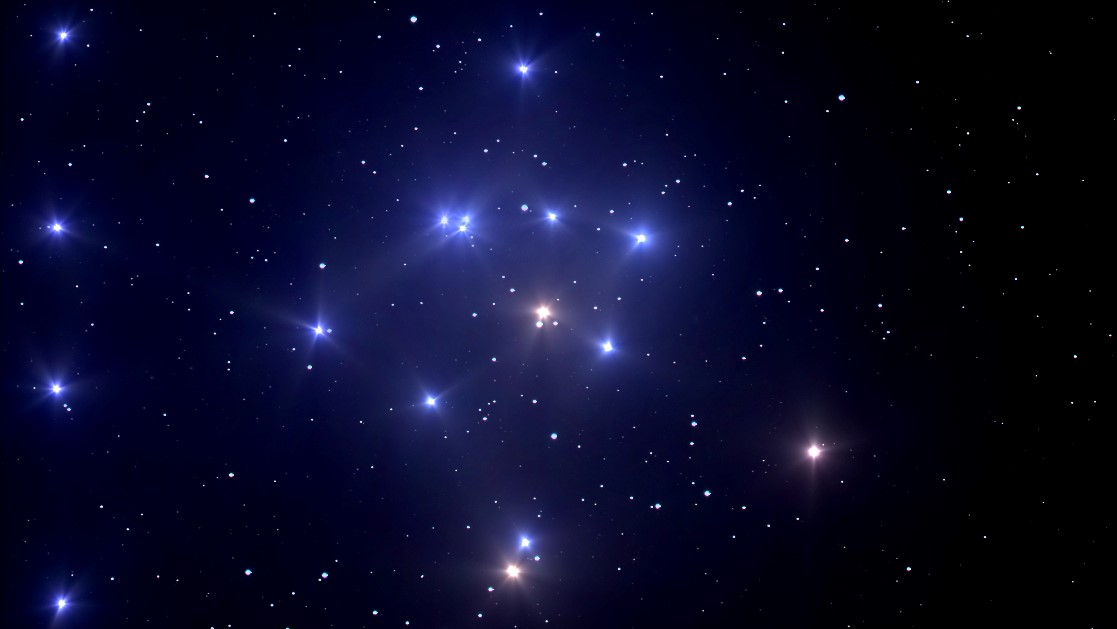THE USM SOUTHWORTH PLANETARIUM
207-780-4249 www.usm.maine.edu/planet
43.6667° N 70.2667° W
Altitude: 10 feet below sea level
Altitude: 10 feet below sea level
Founded January 1970
Julian date: 2458675.5
"Heavens below!"
THE DAILY ASTRONOMER
Thursday, July 11, 2019
Thursday, July 11, 2019
Bees Exit West
 A gorgeous image of the Beehive Star Cluster. In our night sky, it appears more like a diffuse white cloud visible in the center of Cancer the Crab.
A gorgeous image of the Beehive Star Cluster. In our night sky, it appears more like a diffuse white cloud visible in the center of Cancer the Crab.In winter and early spring, one can observe both of our sky's prominent galactic star clusters, the Pleiades (Seven Sisters) and Praesepe (the Beehive) in the evening sky. They resemble diffuse light patches located at either side of the Milky Way's diffuse light bridge. In fact, they look like fragments that flaked off the galaxy band. Unlike the much larger globular clusters lurking around the galactic halo, these open systems travel around the Milky Way's spiral arms with us. Consequently, these open clusters tend to be more prominent owing to our closer proximity to them. The mammoth globulars, confined to the galaxy's center, are far more distant and therefore much more difficult to see.
We have no difficulty observing the Seven Sisters and the Beehive in the winter and spring as they are quite distinctive objects within the star fields. They are particularly beautiful when observed telescopically, as such observations permit us to resolve many more stars: hundreds more, provided the telescope is sufficiently powerful. Even without a telescope, one can still behold lovely clusters, the collective light of which produces a phatom-like glow in the sky.
In May, we lose the seven sisters for awhile as the Sun obscures our view. Throughout the rest of May and June, we can still watch the Beehive Star Cluster drawing closer to the setting Sun. In July, Prasepe sets soon after dark and by mid month we lose it altogether. On August 1, the Sun is directly over the Beehive, itself. By September, it slowly emerges in the pre-dawn eastern sky, where one will currently find the Seven Sisters.
This week, we prepare to bid adieu to the Beehive Star Cluster, so named as they resemble a bee swarm when seen through a telescope. Their passage out of the evening sky marks the arrival of middle Summer. Their return to the morning heralds the return of earliest autumn. While we're still protected from autumn for the moment, we at least know that summer's progressing along nicely. The Beehive's imminent disappearance serves as a handy reminder that the natural cycles continued unabated.
For some, that is quite a comfort.
We have no difficulty observing the Seven Sisters and the Beehive in the winter and spring as they are quite distinctive objects within the star fields. They are particularly beautiful when observed telescopically, as such observations permit us to resolve many more stars: hundreds more, provided the telescope is sufficiently powerful. Even without a telescope, one can still behold lovely clusters, the collective light of which produces a phatom-like glow in the sky.
In May, we lose the seven sisters for awhile as the Sun obscures our view. Throughout the rest of May and June, we can still watch the Beehive Star Cluster drawing closer to the setting Sun. In July, Prasepe sets soon after dark and by mid month we lose it altogether. On August 1, the Sun is directly over the Beehive, itself. By September, it slowly emerges in the pre-dawn eastern sky, where one will currently find the Seven Sisters.
This week, we prepare to bid adieu to the Beehive Star Cluster, so named as they resemble a bee swarm when seen through a telescope. Their passage out of the evening sky marks the arrival of middle Summer. Their return to the morning heralds the return of earliest autumn. While we're still protected from autumn for the moment, we at least know that summer's progressing along nicely. The Beehive's imminent disappearance serves as a handy reminder that the natural cycles continued unabated.
For some, that is quite a comfort.